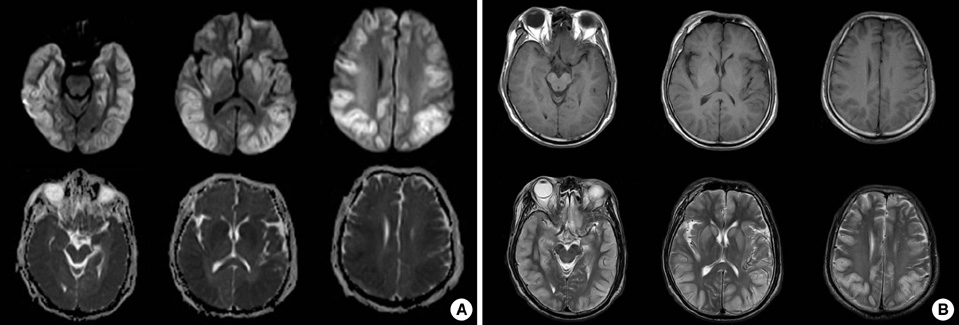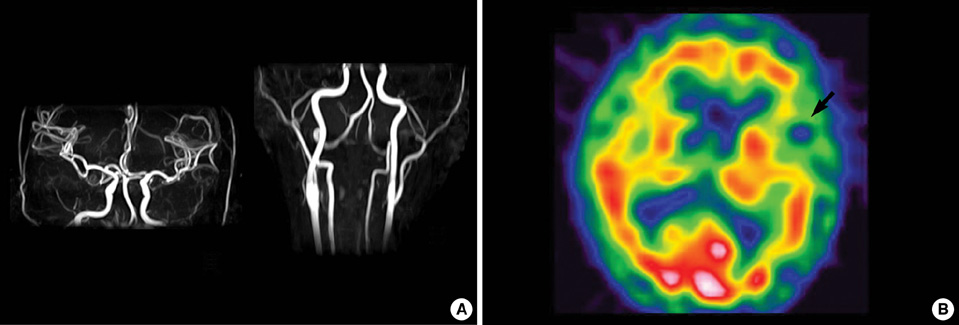J Korean Med Sci.
2010 Jun;25(6):961-965. 10.3346/jkms.2010.25.6.961.
A Case of Hypoglycemic Brain Injuries with Cortical Laminar Necrosis
- Affiliations
-
- 1Department of Neurosurgery, Hangang Sacred Heart Hospital, College of Medicine, Hallym University, Seoul, Korea. neuri71@gmail.com
- 2Division of Cardiology, Department of Internal Medicine, College of Medicine, University of Ulsan, Seoul, Korea.
- 3Division of Endocrinology and Metabolism, Department of Internal Medicine, College of Medicine, Hallym University, Seoul, Korea.
- KMID: 2150881
- DOI: http://doi.org/10.3346/jkms.2010.25.6.961
Abstract
- We report a case of 68-yr-old male who died from brain injuries following an episode of prolonged hypoglycemia. While exploring controversies surrounding magnetic resonance imaging (MRI) findings indicating the bad prognosis in patients with hypoglycemia-induced brain injuries, we here discuss interesting diffusion-MRI of hypoglycemic brain injuries and their prognostic importance focusing on laminar necrosis of the cerebral cortex.
Keyword
Figure
Reference
-
1. Cho SJ, Minn YK, Kwon KH. Severe hypoglycemia and vulnerability of the brain. Arch Neurol. 2006. 63:138.2. Aoki T, Sato T, Hasegawa K, Ishizaki R, Saiki M. Reversible hyperintensity lesion on diffusion-weighted MRI in hypoglycemic coma. Neurology. 2004. 63:392–393.3. Anderson JM, Milner RD, Strich SJ. Pathological changes in the nervous system in severe neonatal hypoglycaemia. Lancet. 1966. 2:372–375.4. Yoneda Y, Yamamoto S. Cerebral cortical laminar necrosis on diffusion-weighted MRI in hypoglycaemic encephalopathy. Diabet Med. 2005. 22:1098–1100.5. Chan R, Erbay S, Oljeski S, Thaler D, Bhadelia R. Case report: hypoglycemia and diffusion-weighted imaging. J Comput Assist Tomogr. 2003. 27:420–423.6. de Courten-Myers GM, Xi G, Hwang JH, Dunn RS, Mills AS, Holland SK, Wagner KR, Myers RE. Hypoglycemic brain injury: potentiation from respiratory depression and injury aggravation from hyperglycemic treatment overshoots. J Cereb Blood Flow Metab. 2000. 20:82–92.7. Christiaens FJ, Mewasingh LD, Christophe C, Goldman S, Dan B. Unilateral cortical necrosis following status epilepticus with hypoglycemia. Brain Dev. 2003. 25:107–112.8. Boeve BF, Bell DG, Noseworthy JH. Bilateral temporal lobe MRI changes in uncomplicated hypoglycemic coma. Can J Neurol Sci. 1995. 22:56–58.9. Fujioka M, Okuchi K, Hiramatsu KI, Sakaki T, Sakaguchi S, Ishii Y. Specific changes in human brain after hypoglycemic injury. Stroke. 1997. 28:584–587.10. Bakshi R, Morcos MF, Gabryel TF, Dandona P. Is fluid-attenuated inversion recovery MRI more sensitive than conventional MRI for hypoglycemic brain injury? Neurology. 2000. 55:1064–1065.11. Finelli PF. Diffusion-weighted MR in hypoglycemic coma. Neurology. 2001. 57:933.12. Spar JA, Lewine JD, Orrison WW Jr. Neonatal hypoglycemia: CT and MR findings. AJNR Am J Neuroradiol. 1994. 15:1477–1478.13. Barkovich AJ, Ali FA, Rowley HA, Bass N. Imaging patterns of neonatal hypoglycemia. AJNR Am J Neuroradiol. 1998. 19:523–528.14. Cakmakci H, Usal C, Karabay N, Kovanlikaya A. Transient neonatal hypoglycemia: cranial US and MRI findings. Eur Radiol. 2001. 11:2585–2588.15. Myers RE, Khan KJ. Bradley JB, Meldrum BS, editors. Insulin-induced hypoglycemia in the nonhuman primate. II: Long-term neuropathological consequences. Brain hypoxia (chapter 20). 1971. 39/40. 195–206. Reprinted in Clin Devel Med.16. Liwnicz BH, Mouradian MD, Ball JB Jr. Intense brain cortical enhancement on CT in laminar necrosis verified by biopsy. AJNR Am J Neuroradiol. 1987. 8:157–159.17. Tippin J, Adams HP Jr, Smoker WR. Early computed tomographic abnormalities following profound cerebral hypoxia. Arch Neurol. 1984. 41:1098–1100.18. Arbelaez A, Castillo M, Mukherji SK. Diffusion-weighted MR imaging of global cerebral anoxia. AJNR Am J Neuroradiol. 1999. 20:999–1007.19. Siskas N, Lefkopoulos A, Ioannidis I, Charitandi A, Dimitriadis A. Cortical laminar necrosis in brain infarcts: serial MRI. Neuroradiology. 2003. 45:283–288.20. Lovblad KO, Wetzel SG, Somon T, Wilhelm K, Mehdizade A, Kelekis A, El-Koussy M, El-Tatawy S, Bishof M, Schroth G, Perrig S, Lazeyras F, Sztajzel R, Terrier F, Rufenacht D, Delavelle J. Diffusion-weighted MRI in cortical ischaemia. Neuroradiology. 2004. 46:175–182.21. Iizuka T, Sakai F, Suzuki N, Hata T, Tsukahara S, Fukuda M, Takiyama Y. Neuronal hyperexcitability in stroke-like episodes of MELAS syndrome. Neurology. 2002. 59:816–824.22. Adams JH, Brierley JB, Connor RC, Treip CS. The effect of systemic hypotension upon the human brain. Clinical and neuropathological observation in 11 cases. Brain. 1966. 89:235–268.
- Full Text Links
- Actions
-
Cited
- CITED
-
- Close
- Share
- Similar articles
-
- Cortical Laminar Necrosis in an Infant with Severe Traumatic Brain Injury
- MRI Findings of Cortical Laminar Necrosis
- Acute Hepatic Encephalopathy Presenting as Cortical Laminar Necrosis: Case Report
- Cortical Laminar Necrosis associated with Osmotic Demyelination Syndrome
- Rapid Regression of White Matter Changes in Hypoglycemic Encephalopathy




